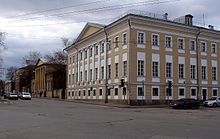|
Nemetskaïa sloboda La Nemetskaïa sloboda (russe : Немецкая слобода) ou sloboda koukouï (russe : слобода Кукуй) est l'ancien quartier « allemand » de Moscou. Apparu au XVe siècle, il était composé majoritairement d'étrangers, dont certains fait prisonniers lors de la Guerre de Livonie, qui étaient appelés « Germains » par les Russes (« nemets » voulant dire en russe « muet »). Il était situé au nord-est de la ville sur la rive droite de la rivière Iaouza, et à l'est du ruisseau Koukouï (d'où son autre nom), dans l'arrondissement actuel de Basmanny du quartier de Lefortovo. Ses limites correspondaient à l'actuelle rue Dobroslobodskaïa et au chemin Bolchoï Demidovsky qui longe le Koukouï à l'ouest, à la rue Spartakovskaïa au nord et à la Iaouza au sud-est. Le Koukouï formait autrefois un vaste étang à l'emplacement de l'actuel chemin Elizavetinsky, sur le site du stade Sokol de l'Université technique d'État de Moscou qui occupe la partie sud de l'ancien quartier allemand. Entre 1666 et 1711, le quartier était géré par l'Ordre de décharge[1]. TransportLa station de métro Baumanskaïa désert le quartier et la rue rue Baumanskaïa en est l'une des principales artères. Le vieux quartier allemandTexte anglais à traduire : New German Quarter After the end of Time of Troubles, downtown Moscow attracted many European settlers, serving the royal court and the numerous foreign soldiers of muscovite troops. In 1640s, however, the clergy persuaded the tsar to limit foreign presence in Moscow, and in 1653 Alexis I of Russia forced all Catholic and Protestant foreigners to relocate to German Quarter, which became known as the New German Quarter (Novonemetskaya sloboda), located east of present-day Lefortovskaya Square, above the mouth of the Chechera River. By 1672, it had three Lutheran and two Calvinist churches and numerous factories, like Moscow's first Silk Manufactory, owned by A.Paulsen. In 1701, J.G.Gregory, based in German Quarter, obtained a monopoly patent for a public pharmacy (hence, the name of Aptekarsky (Pharmacy) Lane). The quarter was populated by merchants, store owners, and foreign officers of the Russian army. Among them were future associates of Peter the Great, such as Patrick Gordon and Franz Lefort. Peter the Great (who grew up nearby, on the eastern bank of Yauza) was a frequent guest in the German Quarter, and he met his mistress Anna Mons there. Deceased residents were buried at the Vvedenskoye Cemetery, also known as German Cemetery, located across Yauza in Lefortovo; this tradition persisted among Lutherans and Catholics until 20th century. In the early 18th century, the usual way of life in the German Quarter started to change. Its territory gradually turned into a construction site for palaces of the nobles, notably Lefort and later Alexander Bezborodko (in 1830s, these palaces became the site of Moscow State Technical University). At the same time, foreigners, not bound by former restrictions, migrated to center of Moscow, for example, the French community settled in Kuznetsky Most. End of "German" presence Throughout 18th century, Russian merchants took over the german businesses and established their own; the shores of Yauza housed P.Belavin's silk factory, N.Ivanov's ribbon factory etc. Fire of 1812 razed the area, and the ruined owners preferred to sell their lands to new owners. By 1826, all foreign landlords sold their land to local merchants and craftsmen; German Quarter lost its ethnic flavor but retained the name of Nemetskaya (German) Street (Baumanskaya Street since 1918). Lutheran churches were never rebuilt; Moscow's Lutheran Cathedral was erected nearly 100 years after the fire in central Basmanny District. The name "German Quarter" itself disappeared from the Moscow lexicon in the mid-19th century. Références
|

